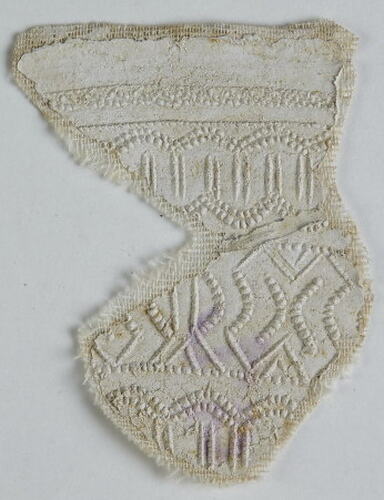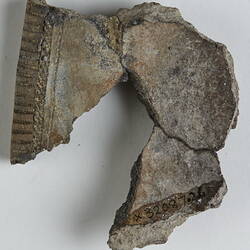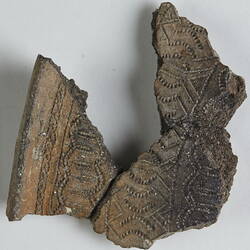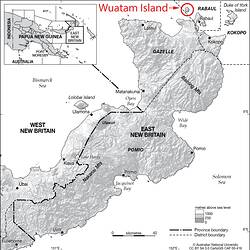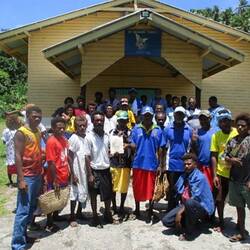Summary
Part of a collection of pottery sherds originating at the small island of Vuatom (Watom) in Papua New Guinea's (PNG's) Bismarck Archipelago. The original object register of the National Museum of Victoria (now known as Museums Victoria) records that the sherds were 'dug up ... found at about a depth of 4 feet, about 50 yards from the high water, on one of the very few level patches of Watom'.
The sherds are ornately decorated with motifs created by impressing a comb-like tool or shell, and by making incisions into the vessel surface before firing.
Archaeologists use the term 'Lapita' to refer to this style of pottery, made by First Peoples who were expert seafarers. Similar pottery has been found in other island and coastal locations in north and north-west PNG, as well as on the south coast. Elaborately decorated pottery has also been found at the earliest archaeological sites in the south-east Solomon Islands, Vanuatu, New Caledonia, Fiji, Tonga and Samoa. The earliest 'Lapita' style pottery found in the Pacific dates to around 3300 years ago, but the Watom Island pottery probably dates to within the period c. 2850-1850 years ago.
Physical Description
Three earthenware sherds which have been adhered together. One of the sherds is from the vessel rim. The exterior surface and interior of the rim are decorated. The interior of the rim is decorated with a row of short indented vertical lines above a row of short indented diagonal lines, under which is a single horizontal line of indentations. The exterior surface has four main fields of decoration, delineated by single horizontal lines composed of small indentations. The first, located just below the rim, is a band of short intersecting diagonal lines. Below this row is a pattern made from wavy and vertically oriented lines. The next set of motifs is made from indented wavy lines and triangle shapes. The final row is composed of a combination of wavy and vertically oriented lines. The lowermost section of the conjoined sherds is blackened (possibly soot from a fire). The indented motifs were probably made by impressing a comb-like tool or part of a shell.
More Information
-
Object/Medium
Potsherd
-
Maker
-
Locality
-
Date Produced
-
Collector
-
Date Collected
-
Object Measurements
98 mm (Length), 79 mm (Width), 20 mm (Depth)
-
Keywords
-
References
[Article - Journal] Casey, Dermot A. 1936. Ethnological Notes. Mem. Mus. Vic. 9
[Book] Craig, Barry, et al. War Trophies or Curios? The War Museum Collection in Museum Victoria 1915-1920.
[Chapter] Spriggs, Matthew. The vicissitudes of Lapita pottery, 1909-45: The Melbourne witness, in Spriggs, Matthew, et al. Uncovering Pacific Pasts: Histories of Archaeology in Oceania. 15.
[Book] Spriggs, Matthew & Bedford, Stuart. 2019. Debating Lapita: Distribution, Chronology, Society and Subsistence. 52. 528.
-
Collection Names
-
Type of item
-
Discipline
-
Category
-
Collecting Areas
